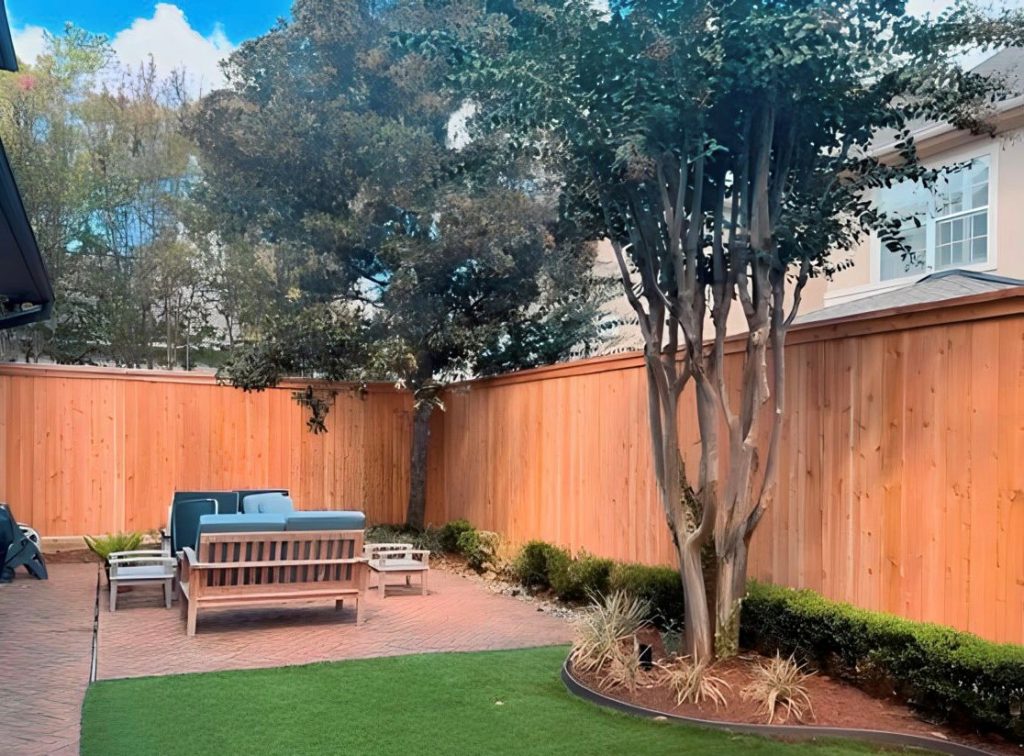Ultimate Guide to Residential Wood Fences
Residential Wood Fences – Installation, Designs, and Maintenance
Are you contemplating adding a touch of elegance, privacy, and security to your home? The route to achieving this is not as complicated as you might think. In this Ultimate Guide to Residential Wood Fences: Installation, Designs, and Maintenance, we’ll help redefine your boundaries with an artistic flair. We’ll walk through everything from the basics of installation procedures and trending design options, right down to their upkeep, ensuring your fence remains a stylish asset for years to come. Join us as we delve into the world of residential wood fences where aesthetics meet functionality. Let’s build more than just barriers; let’s create masterpieces.

Types of Residential Wood Fences
Wooden fences are a popular choice for residential properties due to their timeless appeal, versatility, and natural beauty. When considering a wooden fence for your home, it’s important to understand the different types available. Let’s explore some common options:
- Picket Fence: A classic and charming choice, picket fences consist of evenly spaced vertical wooden boards, known as pickets, attached to horizontal rails. They are typically shorter in height, offering a semi-open feel while still providing some level of privacy and security.
- Privacy Fence: If total seclusion is your goal, a privacy fence is the way to go. Built with closely placed vertical boards that eliminate gaps, these tall fences obstruct views from both sides and create a private sanctuary in your outdoor space.
- Shadow Box Fence: This type of fence offers an aesthetically appealing design with alternate overlapping pickets on each side. It provides privacy as well as a captivating visual effect by allowing light and airflow through the fence without compromising seclusion.
- Split Rail Fence: Often associated with a rustic or country aesthetic, split rail fences are characterized by horizontal wooden rails fitted into vertical posts. They create a more open and natural boundary option while keeping larger animals out.
| Types | Description |
| Picket Fence | A classic choice with evenly spaced vertical pickets for a semi-open feel. |
| Privacy Fence | Provides complete seclusion with closely placed vertical boards. |
| Shadow Box Fence | Alternating overlapping pickets offer privacy while allowing light and airflow. |
| Split Rail Fence | A rustic option consisting of horizontal wooden rails fitted into vertical posts. |
Material Choices for Wood Fences
When it comes to materials for wood fences, you have several options that vary in terms of durability, appearance, and maintenance requirements. Each type of wood offers its unique characteristics and can greatly impact the overall look and longevity of your fence. Let’s explore some common choices:
- Cedar: Known for its natural resistance to decay and rot, cedar is a popular choice for wooden fences. It features a beautiful reddish-brown hue and distinct grain patterns that add visual appeal to any property. Cedar fences are relatively low maintenance, requiring periodic sealing to maintain their integrity.
- Redwood: Similar to cedar, redwood possesses natural oils that make it resistant to insects, decay, and rot. It has a rich, reddish color that weathers over time to an attractive gray tone. Redwood fences are durable and can withstand diverse climates with proper maintenance.
- Pressure-Treated Pine: Pressure-treated pine is a cost-effective option that has been chemically treated to resist decay and insect infestation. While it may not have the same natural beauty as cedar or redwood, it offers durability and can be stained or painted to match any aesthetic.
- Tropical Hardwoods: For those seeking maximum longevity and resilience, tropical hardwoods like ipe or mahogany are excellent choices. They are incredibly dense, resistant to rot and pests, and can last for decades when properly maintained. However, they tend to be more expensive and require specialized installation techniques.
It’s important to note that any wood used in fencing should be properly treated or finished to protect against moisture damage and prolong its lifespan. Regular staining or sealing is recommended to maintain the appearance of the fence while protecting it from the elements.
Picking the Right Style: From Picket to Privacy
When it comes to residential wood fences, one of the most critical decisions you’ll have to make is choosing the right style. The style you select will not only impact the overall aesthetics of your property but also determine the level of privacy and security provided. Let’s explore some popular options and their characteristics.
Picket Fence: This classic style features evenly spaced vertical boards attached to horizontal rails. Picket fences are known for their charming and quaint look, adding an inviting touch to any home. They are typically shorter in height, providing a more open and decorative feel while still establishing a boundary.
Imagine strolling through a neighborhood with a white picket fence lining the front yards, exuding a sense of warmth and nostalgia. It’s important to note that picket fences do not offer much privacy, making them ideal for showcasing gardens or defining boundaries without obstructing views.
Privacy Fence: As the name suggests, this style is designed to provide maximum privacy. A privacy fence consists of tall, closely spaced vertical boards that are tightly fitted together, leaving little to no gaps between them. This type of fence creates a secure and secluded sanctuary within your property boundaries.
Picture yourself relaxing in your backyard with complete seclusion from prying eyes. A privacy fence shields your activities from view while creating a serene atmosphere. Keep in mind that these fences can be imposing due to their height, so they may not be suitable for those seeking an open and airy aesthetic.
Shadowbox Fence: Similar to the privacy fence, a shadowbox fence consists of closely spaced boards. However, unlike its solid counterpart, it alternates the positioning of the boards on each side of the rails. This design creates an attractive visual effect by casting shadows and providing some airflow through the fence.
Visualize walking along the back of your property and admiring the alternating shadow patterns created by your fence. A shadowbox fence strikes a balance between privacy and openness while adding a touch of elegance to your outdoor space.
Board-on-Board Fence: This style takes the concept of the shadowbox fence a step further. Instead of alternating boards on each side, boards are placed side by side with small gaps in between. The result is a fence that offers excellent privacy while maintaining an appealing appearance from both sides.
Envision enjoying a gathering in your backyard, knowing that the board-on-board fence ensures complete privacy for you and your guests. With no visible gaps, this style creates a visually seamless barrier while providing excellent protection against unwanted views.
Cost Estimation for Wood Fence Installation
The cost of installing a wood fence can vary depending on several factors, including the style chosen, the size of the project, and regional labor and material costs. It’s essential to have a realistic understanding of these costs to plan your budget accordingly and avoid any surprises along the way. While specific prices will differ based on location and specific project details, here is a general breakdown of cost estimation for wood fence installation:
Think of estimating the cost of installing a wood fence as planning a trip. You need to consider various expenses such as transportation, accommodation, and activities to create an accurate budget.
Materials: The materials themselves play a significant role in determining the cost of your wood fence. Different types of wood come at different price points, with some options being more affordable than others. For example, cedar or pine tends to be more budget-friendly compared to higher-end options like redwood or cypress.
Fence Height: The height of your wood fence will also impact the overall cost. As a rule, taller fences require more materials and labor to install, resulting in a higher price tag. Consider the purpose of your fence and your specific needs to determine the appropriate height.
Labor: The complexity and size of your project will influence the amount of labor required, which in turn affects the cost. Factors such as terrain, slope, and any additional customization or gate installation can contribute to increased labor costs.
For instance, if you have a large yard with uneven terrain and want a custom gate incorporated into your fence design, expect that these factors will add to the overall installation expenses.
Additional Features: Be mindful of any additional features or enhancements you may want for your wood fence. This could include decorative elements like finials or lattice panels, which can elevate the aesthetic appeal but also increase the overall cost.
By considering all these factors together, you’ll be able to estimate a realistic budget for your wood fence installation. Remember to obtain multiple quotes from reputable contractors for accurate price comparisons.
Design and Customization Options for Wood Fences
Wood fences are a timeless and versatile choice for residential properties, offering an appealing aesthetic that complements various architectural styles. When it comes to design and customization options for wood fences, homeowners have a range of possibilities to explore.
First and foremost, there are different fence designs to consider. Traditional picket fences feature evenly spaced vertical boards with pointed or rounded tops, creating a classic look that enhances curb appeal. For those seeking more privacy, a solid board fence consisting of tightly placed horizontal boards can be an excellent choice.
Picture a charming cottage-style home adorned with a white picket fence that evokes feelings of warmth and nostalgia. Alternatively, envision a sleek modern home with a smooth, stained cedar fence offering privacy while still showcasing the beauty of natural wood.
Design variations also exist within these categories. Picket fences, for instance, can come in different heights and configurations—ranging from shorter pickets for decoration to taller ones for added security. Additionally, adding decorative elements like lattice panels or scalloped tops can elevate the overall design.
“When we decided to install a wood fence around our backyard, we opted for a custom design. We wanted something unique that would reflect our personal style and enhance the aesthetics of our home. Working closely with the fencing company, we came up with an elegant combination of horizontal slats and lattice work that perfectly complemented our Victorian architecture.”
Customization extends beyond design alone; it encompasses other factors such as wood species selection and finishing options. Different types of wood offer distinct characteristics in terms of durability, grain patterns, and color variations. Popular choices include cedar and redwood due to their natural resistance to decay and insect damage.
Color, Texture, and Design
The color of a wood fence can greatly impact its visual appeal, with homeowners having the option to enhance or alter the natural hue of the wood through staining or painting. Some may prefer the warm, earthy tones of natural wood grains, while others may opt for more vibrant shades that complement their home’s exterior.
Staining is a popular choice as it allows the natural beauty and texture of the wood to shine through while providing protection against UV rays, moisture, and rot. Different stain colors are available, ranging from light and transparent finishes that showcase the wood’s natural qualities to darker tones that add depth and richness.
Imagine a backyard with a beautiful cedar fence stained in a rich mahogany color. The warm undertones of the stain highlight the natural grain patterns of the wood, creating an inviting and elegant atmosphere.
Painting is another option for those seeking a different look or wanting to match their fence with other elements of their home’s exterior. Homeowners can choose from a wide array of paint colors, allowing them to coordinate with their home’s facade or express their personal style.
It’s important to note that each choice—whether staining or painting—has different maintenance requirements. Stains typically need to be reapplied every few years, depending on factors such as weather exposure, while painted fences may require periodic touch-ups to maintain their appearance.
Designing and customizing a wood fence offers homeowners an opportunity to create a unique outdoor space that reflects their style and enhances their property’s charm. By exploring various design options and considering color, texture, and finishes, individuals can achieve a fence that seamlessly blends functionality with aesthetics.
The Art of Maintaining Your Wood Fence
Congratulations! You’ve invested in a beautiful wood fence for your residential property. A well-maintained wood fence not only enhances the aesthetic appeal of your home but also provides privacy, security, and adds value to your property. However, to ensure that your wood fence remains in optimal condition for years to come, it’s essential to engage in regular maintenance. Let’s explore the art of maintaining your wood fence and the steps you can take to keep it looking its best.
Inspect and Clean Regularly: Just like any other structure, your wood fence needs regular inspections to identify any issues or signs of wear and tear. Inspect the entire perimeter and pay attention to areas where moisture might accumulate, such as around the base or near sprinkler systems. Look for signs of rot, termite infestation, loose boards, or loose nails. If you notice any damage or potential problems, address them promptly to prevent further deterioration.
Clean and Remove Debris: Over time, dirt, dust, moss, algae, and other debris can accumulate on the surface of your wood fence. Regular cleaning helps preserve both the appearance and lifespan of your fence. Start by removing any vegetation or weeds growing near the fence that may contribute to moisture retention. Then, use a garden hose with a nozzle attachment or a power washer set on low pressure to wash away dirt and grime. For stubborn stains or mildew, create a solution of mild detergent and water and scrub gently with a soft brush before rinsing thoroughly.
For instance, imagine having a beautiful cedar wood fence that has accumulated a layer of dirt over time due to its exposure to the elements. By conducting regular cleaning using gentle techniques like hose washing or mild detergent solution application, you can restore its natural beauty and extend its longevity.
Apply Stain or Paint: One of the essential aspects of wood fence maintenance is protecting the wood from moisture, sun damage, and decay. Applying a protective stain or paint helps seal the wood, preventing water penetration and reducing the risk of rot. Before applying any stain or paint, make sure to clean the surface thoroughly and let it dry completely. Choose a high-quality exterior-grade stain or paint that provides UV protection and follow the manufacturer’s instructions for application. Regularly inspect the finish and reapply as necessary to maintain its protective qualities.
Imagine your wood fence as a beautiful piece of artwork. Just like an artist would apply a protective layer to their masterpiece to preserve its beauty, you too need to apply stain or paint to your wood fence to protect its natural elegance from Mother Nature’s elements.
Trim Vegetation: Overgrown vegetation, such as bushes, vines, or tree branches, can place additional stress on your wood fence. It’s essential to trim back any plants that come into contact with the fence as they can trap moisture against the wood, leading to decay and potential damage. By maintaining a clear buffer zone between vegetation and your fence, you ensure proper airflow and reduce the risk of moisture-related issues.
Repair Damage Promptly: No matter how well you maintain your wood fence, occasional repairs may be necessary. As soon as you notice loose boards, broken panels, or damaged hardware, take immediate action to prevent further structural problems. Replace any rotted or damaged sections and tighten loose nails or screws. Regularly inspecting and repairing minor issues will help avoid costly repairs down the line.
Protect from Ground Moisture: Since wood fences are in constant contact with soil, it’s crucial to protect them from ground moisture. Direct soil contact can accelerate rotting processes. To mitigate this risk, create a gap between the bottom of your fence panels and the ground, allowing for proper airflow and reducing moisture absorption. Consider using gravel or a drainage system along the fence line to improve drainage and prevent excessive moisture accumulation.
By following these essential practices and making wood fence maintenance a regular part of your home care routine, you can enjoy the beauty, privacy, and functionality provided by your wood fence for many years to come. Remember that prevention is key, so stay vigilant with inspections, cleaning, repairs, and ensure proper protection. With care and attention, your wood fence will continue to enhance your home’s appeal and provide a welcoming barrier for years to come.








